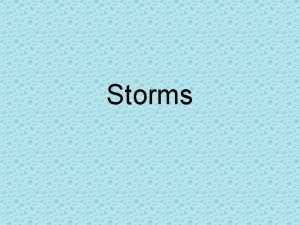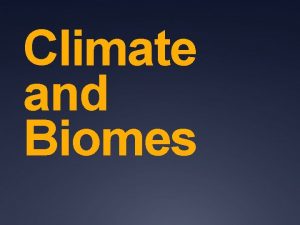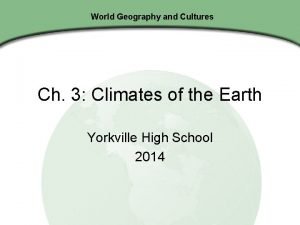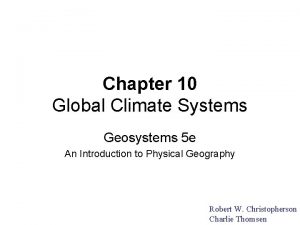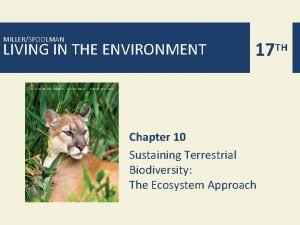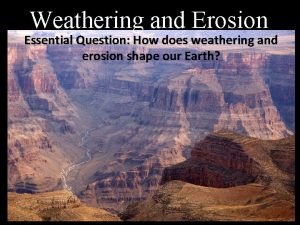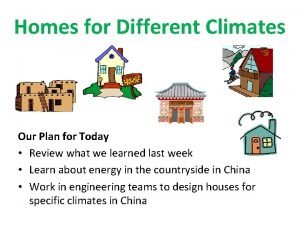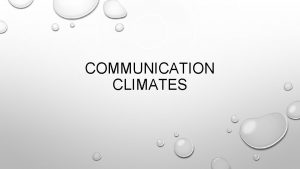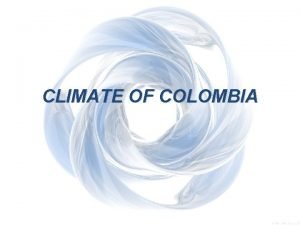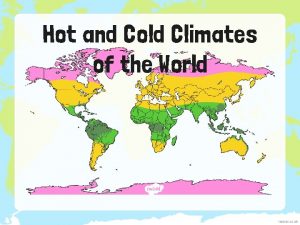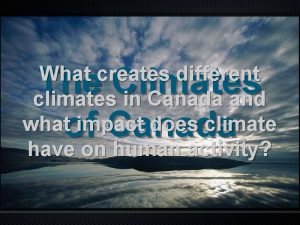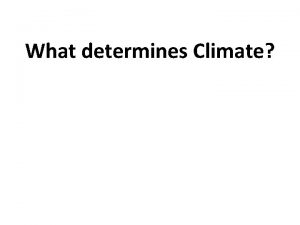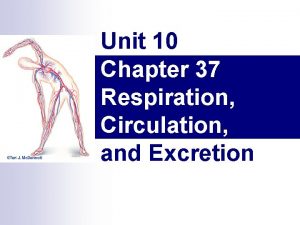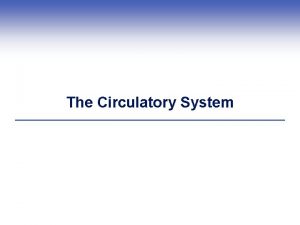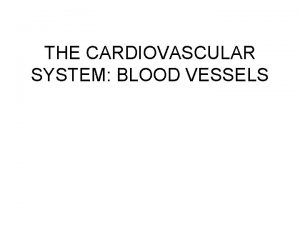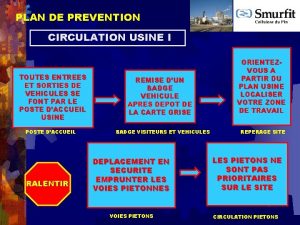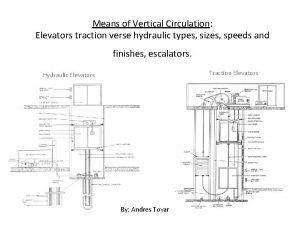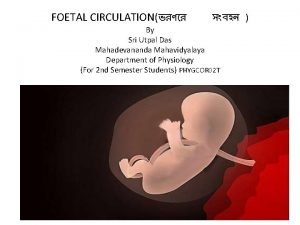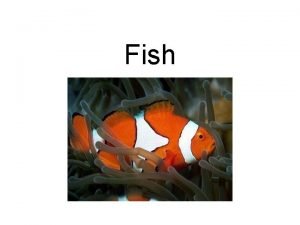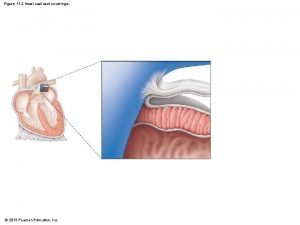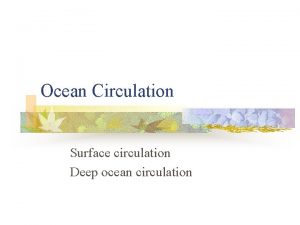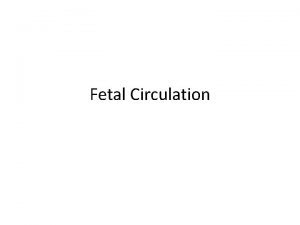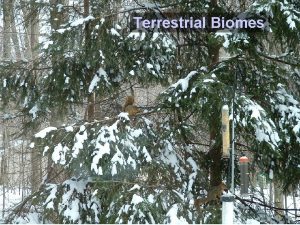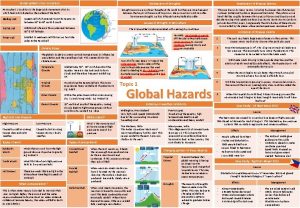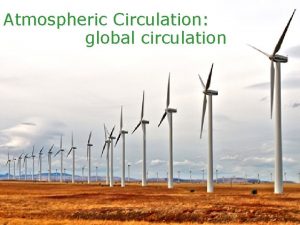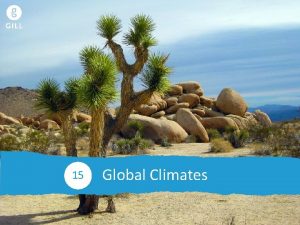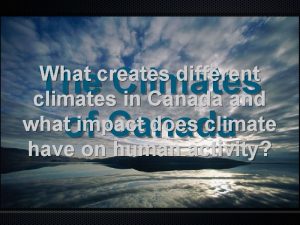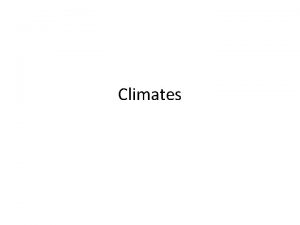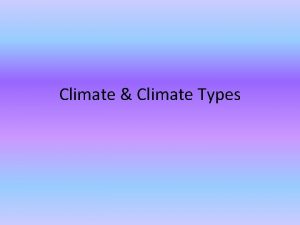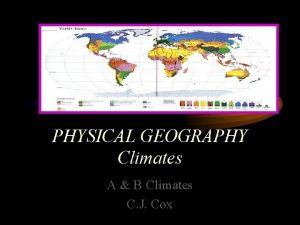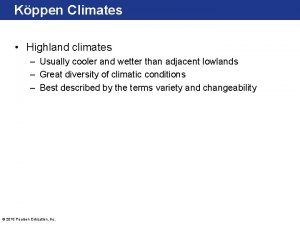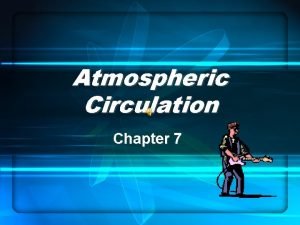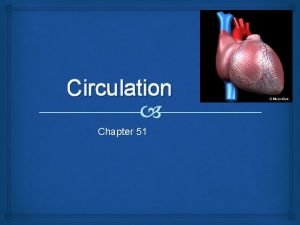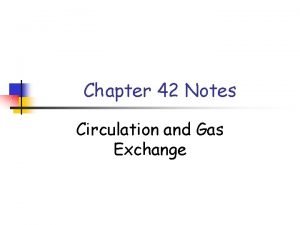World climates World climates Circulation of air in

































- Slides: 33

World climates

World climates • Circulation of air in the atmosphere • • Low pressure High pressure Wind belts High and low pressure belts Distribution of energy Earth´s tilt and rotation Seasons Position of the sun

World climates Global temperature Latitude Distance from the sea Prevailing winds Ocean currents Altitude

World climates Rainfall Relief Frontal Convectional

Name: equatorial Latitude: 5º of the Equator Location: drainage basins of the Amazon and Congo rivers, extreme south-east of Asia Temperature: high and constant around 26ºC, annual range 2ºC Rainfalls: annual total 2000 mm convectional thunderstorms, 2 -3 drier months Winds: light and variable Humidity: high Seasons: lack of seasonal change Weather pattern: uniform 12 hours daylight/darkness

tropical continental Name: Latitude: 5º to 15º of the Equator Location: Brazilian Highlands, Venezuela, northern Australia, Congo basin Temperature: high but no so constant 25 – 34ºC slightly higher Rainfalls: annual around 900 mm convectional thunderstorms, unreliable Winds: prevailing winds from the east Humidity: variable Seasons: dry (cooler) and wet season (hot with sun overhead) Weather pattern: when sun overhead temperature increases, rainfall increases too, afternoon convectional rains – like equatorial, dry is cooler season, wind increases, humidity decreases - desert

monsoon Name: Latitude: Location: South-east Asia Temperature: annual range low, between 24 and 30ºC Rainfalls: annual around 2000 mm (shorter period) Winds: prevailing winds from the south-west and north-east Humidity: variable Seasons: two seasons – south-west monsoon and north-east monsoon based on prevailing winds Weather pattern: summer father from the sea – low pressure – wind from the ocean – relief rainfall, risk of flooding - rise in winter high pressure, wind blows outward, little rain from dry areas risk of drought

Name: Mediterranean Latitude: 30º to 40º of the Equator Location: area surrounding Mediterranean Sea, California, Chile, southern Australia Temperature: between 14 and 26ºC Rainfalls: annual around 500 mm unevenly distributed Winds: in summer from the land in winter from the sea Humidity: variable Seasons: summers hot/dry and winters warm/wet Weather pattern: in summers prevailing winds from warm land with dry land surface, several months of dry sunny weather, winters are warm, winds blow from the sea – warm and moist air – relief rainfall

Name: cold Latitude: 60º of the Equator Location: Scandinavia, Russia, Pacific, North America, central Alaska, northern Canada Temperature: high annual range of 40 severe winters - 25ºC Rainfalls: precipitation is light air too cold to hold moisture occasional convectional Winds: strong winds lower temperatures, wind chill factor Humidity: low Seasons: Weather pattern: summers relatively warm long hours of daylight, far from the sea winters very long and dark, little sun, no influence of the sea strong winds

World climates • Tropical cyclones • formed over tropical oceans with temperatures over 27ºC • considerable depth of warm water • in late summer and early autumn • between latitudes of 5º and 20º of the Equator • releases great heat energy • storm and tidal surges

World climates • Tropical cyclones • • • area of colder air in the centre – a central eye over land rapidly decreases in strength lifespan of 7 -14 days winds exceeding 160 km/hr flooding and polluting bad effect on economy

World climates • Global warming • • • less heat escapes greenhouse gases 0. 6ºC last century carbon dioxide deforestation and burning aerosols

World climates • Global warming • • • rise of sea-levels icecaps and glaciers flooding and drought drinking water ecosystems deceases

World climates • Acid rain • • • from sulphur dioxide and nitrogen oxide dry deposition wet deposition p. H value between 5. 5 – 6 in 1950 s

World climates • Acid rain • • • acidity of lakes acidity of soils nutrients washed health hazard building eroded

• • • Water shortage Water supply Drought Reliability of rainfall Clean water

ecosystems

ecosystems • Ecosystem • Living environment: – Plants (flora) – Animals (fauna) • Non-living environment: – Water – Air – Solar energy – Rocks – Soils

ecosystems Ecosystem Living environment: Plants (flora) Animals (fauna) Non-living environment Water Air Solar energy Rocks Soils

ecosystems • Biomes • Micro • Meso • Global

ecosystems • Energy flows • • main source of energy photosynthesis energy passes through the food chain open system

ecosystems • Recycling of nutrients • • • Closed system Herbivores Carnivores Omnivores Decomposers

Transfers of energy in an ecosystem Non-living environment Producers photosynthesis Consumers herbivores Consumers carnivores Decomposers bacteria

ecosystems • Water cycle • plants need water for photosynthesis • animals use water to remove toxins and stay cool (sweat) • plants and animals - water as a by-product of respiration • animals drink water, consume, too

ecosystems • Carbon cycle • • Photosynthesis Respiration Decomosition Stored

Food absorbed by plant roots Trees use nutrients to grow Nutrients added to soil as leaves decay More nutrients in vegatation cycle takes 6 months Leaves fall to the forest floor Fungi and bacteria rapidly break down into humus

ecosystems • Tropical rainforest • • • constant temperature high rainfall humidity denseness continuous growing season rich ecosystem

ecosystems • Tropical rainforest • • Shrub Under canopy Canopy Emergents

ecosystems • Tropical rainforest • • • rapid decomposition nutrients convectional rainfall human intervention Clearing rainforest Loss of animal habitat Fertile soils Land clearance for farming Roads

ecosystems • Tropical savanna grassland • Dry season – Losing leaves – Changing colour – Xerophytic plants • Wet season – Quick growth – Green sea • Desertification • Fuelwood

ecosystems • Mediterranean • Woodland scrub • Evergreen oaks (dub) • Adaptation – – Waxy leves Protective bark Long roots Short life cycle • Deforestation • Grazing animals • Fire

ecosystems • Coniferous • • • Spruce (smrek), pine (borovica) and fir (sosna) Low temperatures Low precipitation Short growing season Poor soils Little undergrowth

ecosystems • • Deforestation Clearance for farming Building roads Logging • • Selective Integrated Clearfelling Strip cutting • Sustainable forestry
 Single circulation and double circulation
Single circulation and double circulation Single circulation and double circulation
Single circulation and double circulation Pulmonary arterioles
Pulmonary arterioles Circulation of air masses
Circulation of air masses What determines a region's climate
What determines a region's climate Unit 6 lesson 1 climates of the world
Unit 6 lesson 1 climates of the world World geography chapter 3 climates of the earth answers
World geography chapter 3 climates of the earth answers Hubungan air dengan tanah
Hubungan air dengan tanah What impact does the ocean have on climate brainpop
What impact does the ocean have on climate brainpop Explain how köppen’s climate system classified climates.
Explain how köppen’s climate system classified climates. Unfenced grasslands in tropical and temperate climates
Unfenced grasslands in tropical and temperate climates Weathering
Weathering Houses in different climates
Houses in different climates Communication climate definition
Communication climate definition Thermal floors in colombia
Thermal floors in colombia Hot and cold world map
Hot and cold world map Climates of france
Climates of france Wind direction canada
Wind direction canada Summers are caused by
Summers are caused by Chapter 37 respiration circulation and excretion
Chapter 37 respiration circulation and excretion Two circulation syndrome
Two circulation syndrome Single loop blood circulation
Single loop blood circulation Structure of blood cells
Structure of blood cells Hepatic portal vein.
Hepatic portal vein. Plan de circulation usine
Plan de circulation usine Frog heart diagram blood flow
Frog heart diagram blood flow Zelinsky model of migration transition
Zelinsky model of migration transition Types of vertical circulation
Types of vertical circulation Liver circulation
Liver circulation Circulation extracorporelle
Circulation extracorporelle Enterohepatic circulation
Enterohepatic circulation Placental circulation flow chart
Placental circulation flow chart Fish gill
Fish gill Intrinsic conduction system of the heart
Intrinsic conduction system of the heart



